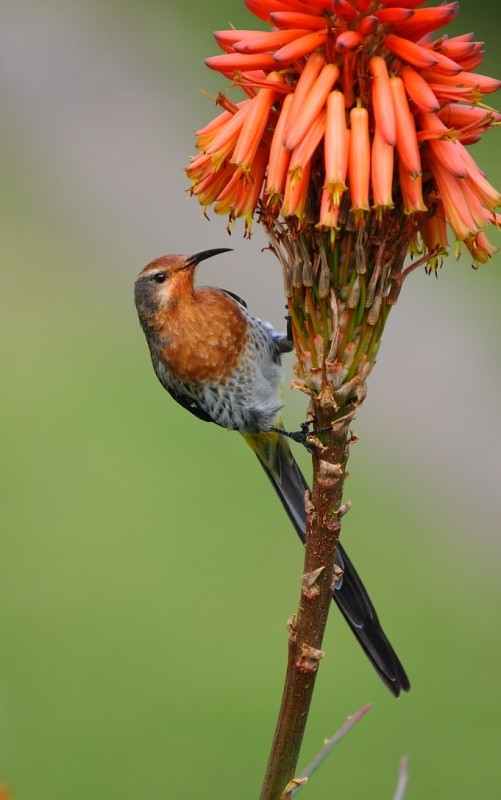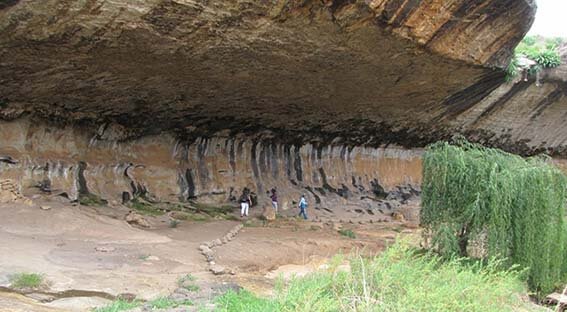Birding in Lesotho will come as a fascinating and surprising entertainment for all the bird lovers as well as ordinary tourists from all over the world, who will be able to view its astonishing variety and beauty first hand.
Lesotho is shelters an impressive number of species of birds. Over 300 varieties have been recorded in the country and vary from residents, that stay all year around, to breeding birds, that spend a good part of the growing season in Lesotho to raise their young, migrants who pass through Lesotho with the seasons, to wintering birds who like to spend a the winter in Lesotho to escape even colder conditions up north. However, many species of birds are relatively common as they are part of the ecosystems of the country.
The Lesotho Drakensberg and Maluti are among the most sought after by bird watchers who come for Birding in Lesotho. You will be bowled out by the sheer variety and number of these colorful birds, some of which are extremely rare. The birds can be seen in the natural parks in the region, with its well known avifauna, as well in isolated spots which host a variety of fauna of Lesotho.
Birds of Lesotho
Lesotho is a habitat to approximately 600 pairs of bird species (about 12% of the world population). Among the species of the checklist of the birds of Lesotho you can find waterfowl and wading birds, a large suite of song birds, raptors, game birds, swifts and nighthawks, etc., many of which occupy several ecosystems simultaneously, as they fly to and from forests, meadows, shorelines of waters, cities and urban green spaces.
Other common birds include Wattled Crane, Drakensberg Siskin, Half-collared Kingfisher, Grey-wing Francolin, Orange-breasted Rock-jumper, Sentinel Rock Thrush, Pale-crowned Cisticola, Sicklewing Chat, Bush Blackcap, Mountain Pipit, Barratt’s Warbler, Southern Grey Tit, Black-headed Canary, Broad-tailed Warbler, Horus Swift, Lammergeier, Buff-streaked Chat, Rock Pipit, Gurney’s Sugarbird, Ground Woodpecker, Cape Eagle Owl, Drakensberg Prinia, Bald Ibis, Yellow Warbler, Cape Vulture, Cape Rock Thrush, Layard’s Tit-babbler, Fairy Flycatcher and Sharp-billed Honeyguide.
When to go for Bird Watching
The best season for bird watching in Lesotho is between the months of October and March.
LESOTHO BIRDING HOTSPOTS
The BirdLife International designated 6 Important Bird Areas (IBAs) in Lesotho. They include:
Upper Senqu River (Mokhotlong)
Centred on an area of near-vertical cliffs of the Maloti Mountain, where the upper reaches of the Senqu (Orange) river have incised deeply into the basalt layers, vegetation is primarily montane grassland, but thick bush and scrub of unique floral species flank the lower gorge walls. Mokhotlong is one of the remotest places in Lesotho a, yet is readily reachable via the Sani Pass. Resident species include the Black Stork, Southern Bald Ibis, Cape Vulture, Ground Woodpecker, Layard’s Warbler, Drakesberg Rockjumper, Sicklewing Chat, Mountain Pipit and Drakensburg Siskin.
Mafika-Lisiu (Leribe)
Mafika-Lisiu is a site dominated by rock formations or cliffs on the front of the Maloti Mountain Range. The surrounding highlands support vegetation that is primarily montane grassland. There is a spectacular road crossing the Maloti Range, built originally to support the building of Katse Dam. Special bird sightings here include the Cape Vulture, Black Harrier, Southern Bald Ibis, Ground Woodpecker, Layard’s Warbler, Drakensberg Rockjumper, Sicklewing Chat, Mountain Pipit and Drakensberg Siskin.
Sehlabathebe National Park (Qacha’s Nek)
A total of 117 bird species has been recorded in Sehlabathebe National Park. The specials include Yellow breasted Pipit and high altitude birds such as Drakensberg Siskin, Mountain Pipit, and Orange breasted Rockjumper and Bearded Vulture. Karoo species such as Sickle-winged Chat may be found juxtaposed with eastern species. Sehlabathebe is not all that far from where there have been recent sightings of Egyptian Vulture and perhaps Rudd’s Lark will be found in the vicinity. Other birds spotted in the park include Cape Vulture, Southern Bald Ibis, Yellow-breasted Pipit and Ground Woodpecker, Cape Weaver, Cape Sparrow, Cape Canary, Common Quail, Stonechat and Cape Bunting. Characteristic, high-altitude species found in the park included Drakensberg Siskin, Mountain Pipit, Orange-breasted Rockjumper, Banded Martin and Sentinel Rock Thrush. Species such as the Laughing Dove, Sicklewinged Chat, Mountain Chat, Thick-billed Lark, Red-winged Starling, Grey-headed Sparrow Passer, Red Bishop and Golden Bishop occur in very low densities in Sehlabathebe.
[/caption]Ts’ehlanyane National Park (Butha-Buthe)
Ts’ehlanyane is centred on high altitude rocky and boulder strewn slopes and outcrops (60–90m high rocks) of the Mechachaneng Ridge and is Lesotho’s largest National Park. The dominant vegetation of the site is montane grassland. However, a few pockets are covered by the High-altitude shrubs. The area holds amazing species avifauna with special bird varieties spotted in the area including the Drakensberg Rockjumper, Cape Vulture, Bearded Vulture, Jackal Buzzard, Lanner Falcon, Ground Woodpecker, Layard’s Warbler, Sicklewing Chat, Mountain Pipit, Southern Bald Ibis and Drakensberg Siskin.
Maliba Mountain Lodge is Lesotho’s only 5-star hotel and is nestled in the mountain slope. There is also the 3-star self catering River Lodge’s which cater for families and larger groups. Maliba is extensively involved in the local communities as well as conservation initiatives. They recently started a Vulture Restaurant within the park and are hoping to have regular visits from these amazing and rare birds.
Sehonghong & Matebeng (Thaba-Tseka)
The site stretches up to the catchment zones of rivers Sehonghong and Matebeng, bordered to the west by the Senqu. Area’s vegetation is dominantly montane grassland with high-altitude shrubs forming a heath of Erica. The summits are generally rocky, with bare, shallow soil patches and rock sheets near the escarpment. Common bird varieties spotted in the area are Drakensberg Rockjumper, Drakensberg Siskin, Sicklewing Chat, Cape Vulture, Layard’s Warbler, Mountain Pipit, Ground Woodpecker, Southern Bald Ibis and Black Harrier.
Gurney's Sugarbird
Upper Quthing Valley is dominated by the steep cliffs beside the 230-m-deep gorge of River Qanatu. The combination of montane grassland, thick bush and scrub flank that the lower gorge walls make area a tremendous birding spot. Upper Quthing Valley is a happy breeding ground for many resident birds like Drakensberg Siskin, Mountain Pipit, Sicklewing Chat, Drakensberg Rockjumper and Layard’s Warbler, Ground Woodpecker, Southern Bald Ibis and other exotic bird species. There are several winter birds like the Cape Vulture.
Sani Pass
Sani Pass is one of the top birding hotspots in Southern Africa. As the only road running from east to west over the Drakensberg escarpment, it offers a unique opportunity for fantastic birding in a wide range of escarpment and alpine habitats, together with spectacular scenery. Almost every bird encountered is an endemic or a special, including four species namely the Drakensberg Rock-jumper, Drakensberg Siskin, Mountain Pipit and the Bearded Vulture not found elsewhere in southern Africa. Of the 200-odd species that occur in the area, about 40 are endemic, and a typical trip list is around 60 species.
The special birds of the region are to be found in their greatest concentrations from the foot of the pass include Bush Blackcap, Cape Grassbird, Dark-capped Yellow Warbler, Cape Rock-Thrush, Gurney’s Sugarbird, Buff-streaked Chat, Red-winged Francolin, Barratt’s Warbler, Wailing Cisticola, Sentinel Rock-Thrush, Sickle-winged Chat, Large-billed Lark, Southern Bald Ibis, Mountain Pipit, African Rock Pipit, and Grey-winged Francolin. Karoo Prinia, Fairy Flycatcher, Yellow Canary and Grey Tit are regular, while Black-headed Canary and Layard’s Tit-Babbler are occasional. Raptors include Cape Vulture, Black Harrier, and Jackal Buzzard, while Cape Eagle-Owl is a rare sighting. All birding is conducted from the single road up and down the pass between 6am and 6pm.






3 Comments
I love learning about these birds in Lesotho. The reason I’m researching them is because I’m doing a project in world geography but it’s really interesting me I’m glad I got Lesotho to do research on.
Fantastic website. Plenty of useful info here. I’m sending it to a few buddies ans also sharing in delicious. And obviously, thanks on your effort!
I am pleased to see that this information has been captured very well especially for potential tourists in Lesotho.
Book your stay in Lesotho and enjoy the birds and much more